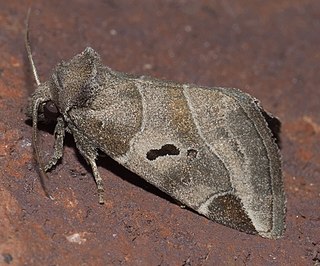
The Noctuidae, commonly known as owlet moths, cutworms or armyworms, are a family of moths. They are considered the most controversial family in the superfamily Noctuoidea because many of the clades are constantly changing, along with the other families of the Noctuoidea. It was considered the largest family in Lepidoptera for a long time, but after regrouping Lymantriinae, Catocalinae and Calpinae within the family Erebidae, the latter holds this title now. Currently, Noctuidae is the second largest family in Noctuoidea, with about 1,089 genera and 11,772 species. This classification is still contingent, as more changes continue to appear between Noctuidae and Erebidae.

Amphipyra is a genus of moths in the family Noctuidae, the only genus in the tribe Amphipyrini.

The Noctuinae are a subfamily of the family Noctuidae, and is composed of moths. The larvae of many species feed on roots or stems of various grasses. Some are generalist feeders which makes them potential pests.

Acontiinae is a subfamily of bird dropping moths in the family Noctuidae. There are more than 50 genera and 430 described species in Acontiinae, found worldwide in temperate and tropical climates.
Hadeninae was formerly a subfamily of the moth family Noctuidae, but was merged into the subfamily Noctuinae. The tribes Apameini, Caradrinini, Elaphriini, Episemini, Eriopygini, Hadenini, Leucaniini, Orthosiini, and Xylenini were moved from Hadeninae to Noctuinae.

Amphipyrinae is a subfamily of owlet moths in the family Noctuidae. There are more than 50 genera and 210 described species in Amphipyrinae, although the classifications are likely to change over time.

Hadenini is a tribe of cutworm or dart moths in the family Noctuidae. There are more than 140 genera and 1,000 described species in Hadenini, found worldwide.

Austramathes is a genus of moths of the family Noctuidae. It is endemic to New Zealand.

Crocigrapha is a genus of moths of the family Noctuidae. It contains one species, Crocigrapha normani, commonly called Norman's quaker. It is found primarily in eastern North America, although it has been reported as far west as Alberta and Colorado.

Drasteria is a genus of moths in the family Erebidae.

Emmelia is a genus of bird dropping moths in the family Noctuidae, found primarily in Africa and the Palearctic.
Megalodes is a genus of bird dropping moths in the family Noctuidae. This genus has a single species, Megalodes eximia.

Panemeria is a genus of owlet moths in the family Noctuidae.

Physetica is a genus of moths of the family Noctuidae. This genus is endemic to New Zealand.

Stiriinae is a subfamily of owlet moths in the family Noctuidae. There are more than 20 genera and 130 described species in Stiriinae.
Stiriina is the name of a former subtribe of moths in the Noctuidae family. It was elevated in rank to the subfamily Stiriinae as a result of phylogenetic research published in 2019 by Keegan, et al.

Stiriini is a tribe of owlet moths in the family Noctuidae. There are about 16 genera and more than 90 described species in Stiriini.

Metoponiinae is a subfamily of owlet moths in the family Noctuidae. There are about 16 genera and more than 70 described species in Metoponiinae.

Chamaecleini is a tribe of bird dropping moths in the family Noctuidae. There are about 9 genera and 14 described species in Chamaecleini.

Grotellinae is a subfamily of owlet moths in the family Noctuidae. There are about 5 genera and more than 20 described species in Grotellinae. They are found primarily in North and Central America, and are common in the southwestern United States.
















